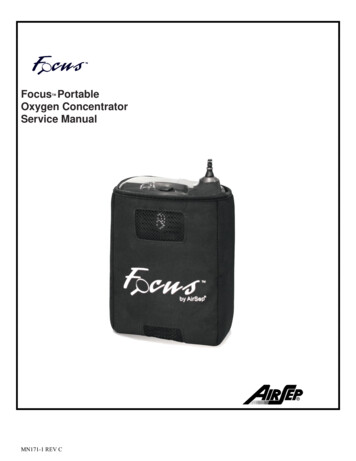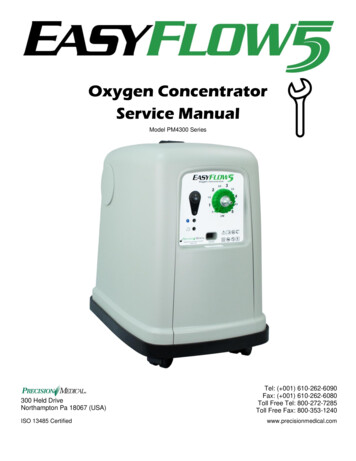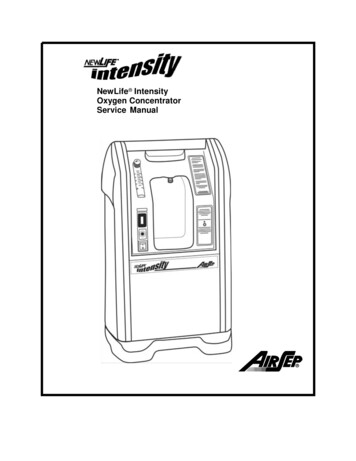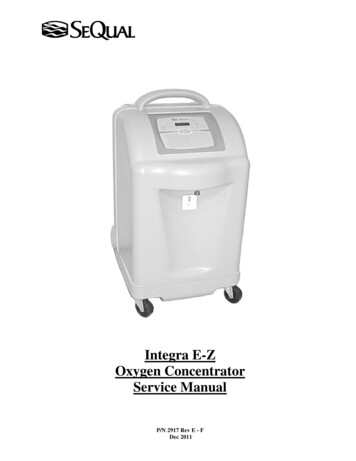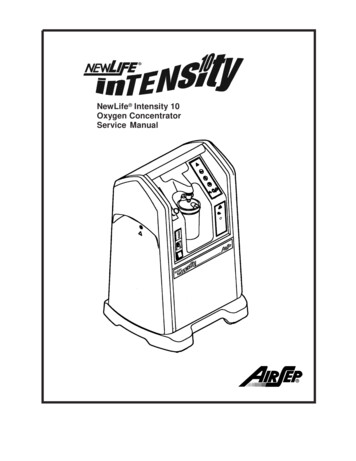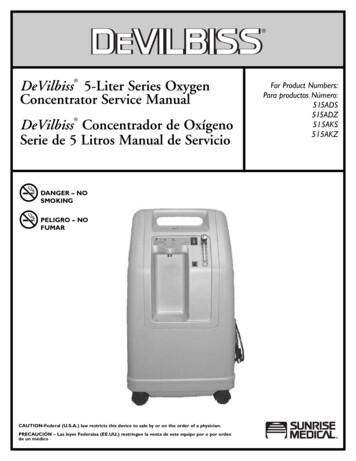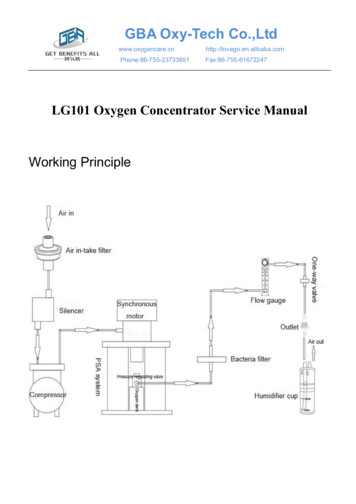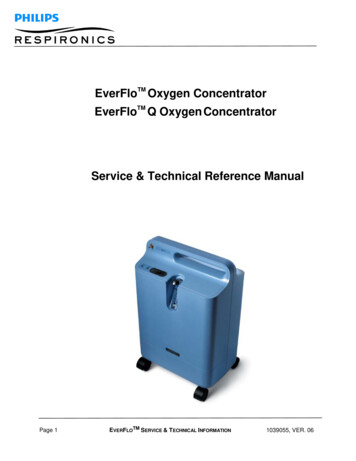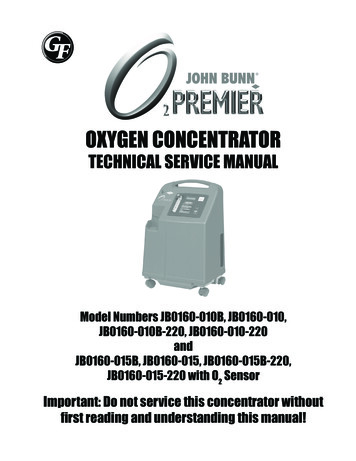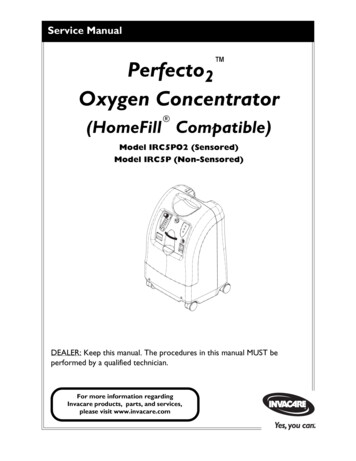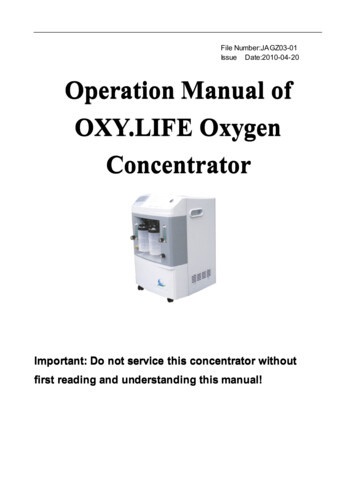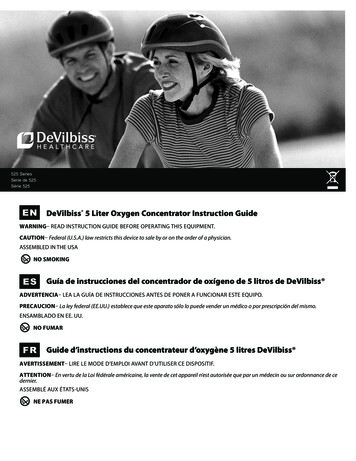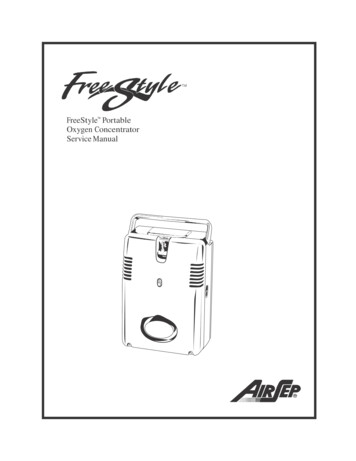
Transcription
FreeStyle PortableOxygen ConcentratorService Manual
Expedited Product Warranty Check service is available at 800-482-2473Air Travel with FreeStyleFreeStyle is approved for use on-board commercial aircraft per an addendum to FAA SFAR106. MN126-1Rev. E
Table of ContentsSection 1.0Introduction1.1Equipment Provider Responsibility1-11.2Important Notice and Symbol Explanations1-21.3Definitions of Symbols1-31.4FreeStyle Specifications1-41.5FreeStyle Classifications1-52.1Description of Operation2-12.2Operation Check2-12.3Alarm System2-22.3.1Start-up2-22.3.2Battery Status2-22.3.3Low Battery2-22.3.4Discharged Battery2-22.3.5Battery Charging2-32.3.6Battery Fully Charged2-42.3.7Cannula Disconnect2-42.3.8Performance Warning2-42.3.9FreeStyle Capacity Exceeded2-42.3.10General Malfunction2-4Section 2.0Operation Check andTest of Oxygen Concentration2.4Oxygen Concentration Test and Specification2-53.1General Instructions3-13.1.1 Connecting t o E x t e r n a l Power3-13.1.23-1Section 3.0Patient Instructions3.2Optional AirBelt BatteryRoutine Maintenance by the Patient3-4i – table of contents
Cleaning the Air IntakeGross Particle Filter3-43.2.2Alarm/Service Indicator3-53.2.3Nasal Cannula3-53.2.4Usage During Sleep3-53.2.1Section 4.0Equipment ProviderMaintenance4.1No Scheduled Maintenance4-14.1.1Air Intake / Gross Particle Filter4-14.1.2Product Filter Replacement4-14.1.3Compressor Servicing4-24.1.4Recording Maintenance4-24.2Infection Control4-24.3Cleaning and Preparing for New Patient Use4-25.1Components5-15.2Housing Removal5-25.2.1Removing Front Cover5-25.2.2Removing Back Cover5-2Section 5.0Service5.3Internal Battery Replacement5-35.4PSA Removal5-45.5Compressor Replacement5-105.5.1Compressor Assembly Removal5-105.5.2Compressor Assembly Installation5-125.6Product Manifold Replacement5-135.7Solenoid Valve Replacement5-145.8Adsorbent Bed Replacement5-155.9Feed/Waste Manifold Replacement5-175.10Measuring System Pressure5-185.11Hour Meter 1.3Service LED5-195.11.4Toggle/Reset Switch5-205.12ii – table of contentsHour Meter Replacement5-20
5.13Circuit Board Replacement5-215.14Motor Controller Board Replacement5-255.15Control/Key Panel Replacement5-275.16Fan Replacement5-316.1Pressure Profile Quadrant6-17.1General Troubleshooting7-17.2Troubleshooting Chart7-28.1Tools for FreeStyle Service and Maintenance8-1Section 6.0Typical Pressure ProfilesSection 7.0TroubleshootingSection 8.0Recommended Toolsiii – table of contents
1.0Introduction1.1Equipment Provider ResponsibilityAll Equipment Providers of the FreeStyle Portable Oxygen Concentrator mustassume responsibilities for handling, operational check-out, patient instruction, andmaintenance. These responsibilities are outlined below and throughout this manual.This unit is not to be used for life support. Geriatric, pediatric, or any other patients unableto communicate discomfort while using this unit may require additional monitoring. Patientswith hearing and/or sight impairment(s) may need assistance with monitoring alarms.As an Equipment Provider, you must do all of the following: Inspect the condition of each FreeStyle unit immediately upondelivery to your business location. Note any sign of damage,external or internal, on the delivery receipt, and report itdirectly to both the freight company and AirSep Corporationimmediately. Check the operation of each FreeStyle unit before delivery to apatient. Always operate the unit for a minimum of 10 minutes,and check that the oxygen concentration level is withinspecifications, as described in Section 5 of this manual. Deliver FreeStyle units only to patients authorized by a physician’sprescription. FreeStyle must not be used as a life-supportingdevice. Instruct patients how to use FreeStyle in conjunction with thePatient Manual. Instruct patients to notify their physicians and/or EquipmentProviders if they experience any signs of discomfort.Instruct each patient to perform routine maintenance of the air intake grossFilter. (Refer to Section 3.2.) Be available to service each patient at any time. Maintain FreeStyle in accordance with Section 4.0. Repair components and replace parts only as outlined in thismanual. Use only AirSep parts for replacement in FreeStyle OxygenConcentrators.FreeStyle Service Manual MN126-1 E1-1
1.2Important Notice and Symbol ExplanationsAs you review both the FreeStyle Patient Manual and this FreeStyle ServiceManual, pay special attention to the WARNING, CAUTION, and NOTE messages.They identify safety guidelines or other important information as follows:Warning – Describes a hazard or unsafe practice that if not avoided can result in severebodily injury, death or property damageCaution – Describes a hazard or unsafe practice that if not avoided can result in minorbodily injury or property damageNote – Provides information important enough to emphasize or repeatDO NOT OPERATE THIS EQUIPMENT WITHOUT FIRST READING AND UNDERSTANDING THISMANUAL. IF YOU ARE UNABLE TO UNDERSTAND THE WARNINGS AND INSTRUCTIONS,CONTACT YOUR EQUIPMENT PROVIDER BEFORE ATTEMPTING TO USE THIS EQUIPMENT;OTHERWISE, INJURY OR DAMAGE MAY RESULT.Smoking while using oxygen is the number one cause of fire injuries andrelated deaths. You must follow these safety warnings:Do not allow smoking, candles, or open flames in the same room with the device orwithin 5 feet (1.52 meters) of the oxygen-carrying accessories.Smoking while wearing an oxygen cannula may cause facial burns and possibly death.Removing the cannula and putting it on bedding, sofas, or other cushion material willcause a flash fire when exposed to a cigarette, heat source, or flame.If you smoke, these 3 steps may save your life:turn off the oxygen concentrator, take off the cannula, and leave the room where thisdevice is located.“No Smoking – Oxygen in Use” signs must be prominently displayed in the home, orwhere the oxygen concentrator is in use. Patients and their caregivers must be informedabout the dangers of smoking in the presence of, or while using, medical oxygen.1-2FreeStyle Service ManualMN126-1 E
1.3Definitions of SymbolsSymbols are frequently used on equipment and/or the manual in preference to wordswith the intention of decreasing the possibility of misunderstanding caused bylanguage differences. Symbols can also permit easier comprehension of a conceptwithin a restricted space.The following table is a list of symbols and definitions used with the FreeStylePortable Oxygen Concentrator.SymbolDescriptionON (power switch on)SymbolDescriptionOFF (power switch off)Warning – Describes a hazard or unsafepractice that if not avoided can result insevere bodily injury, death or propertydamageClass II Equipment, double insulatedCaution – Describes a hazard or unsafeSafety agency for CAN/CSA C22.2 No.601.1 M90 for medical electricalequipmentpractice that if not avoided can result inminor bodily injury or property damageNote – Provides information importantenough to emphasize or repeatKeep unit and accessories dryConsult the accompanyingdocumentsProper disposal of waste of electrical andelectronic equipment requiredUse no oil or greaseDo not disassembleNo smokingConsult instructions for useType BF equipmentDo not expose to open flamesOxygen outlet connection to thecannulaDo not block fanCaution: Federal law (USA) restrictsthis for sale or rental by or on the orderof a physician or licensed health careprovider.RTCA DO160 Section 21Category M Compliant. FAASFAR 106 requirementFreeStyle Service Manual MN126-1 ESafety agency for CAN/CSA C22.2 No.601.1 M90 for medical electricalequipment1-3
1.4FreeStyle SpecificationsOxygen Concentration:*1-3 pulse settings; equivalent to a continuous flow of90% 5.5/-3% Oxygen ConcentrationDimensions:8.6 in. high x 6.1 in. wide x 3.6 in. deep(21.8 cm high x 15.5 cm wide x 9.1 cm deep)Weight:4.4 lb (2.0 kg); 1.8 lb (.8 kg) optional AirbeltAC Power Supply: 100 – 240 VAC (1.0 amp at 120 VAC)Universal Power Supply: DC Power Supply: 11-16 VDC (6.0 amps max. at 13.5 VDCnominal)FreeStyle unit: 28 W nominal at 3 settingBattery duration:3 setting - 2 hours; 2 setting - 2.5 hours; 1 setting - 3.5 hoursOptional AirBelt when combined with the internal battery:3 setting - 5 hours; 2 setting - 6 hours; 1 setting -10 hoursBattery charge time:3.5 hours; optional AirBelt: 3 hoursWarm-up time:2 minutesBattery cycle life:Approximately 300 cycles, then 80% capacity or belowAudible alarms andpulse visual indicators:Start-up – audible and visual (GREEN indicator light); Pulseflow – visual (GREEN light); Battery condition – batterylevel (GREEN indicator lights); Cannula disconnect- audibleand visual (RED alarm light); System overdraw –audible and visual (RED warning and alarm lights); High andlow pressure – audible and visual (RED alarm light);Service required: visual (YELLOW alarm light)Sound:38 dBA at 1 Setting: 41 dBA at 2 setting: 44 dBA at 3 settingTemperature rangeintended for use:Operational temperature: 41oF to 104oF (5oC to 40oC)Storage temperature:-4oF to 140oF (-20oC to 60oC)Max OperationalAltitude:up to 12,000 ft (3,657.6 m) (483mmHg) Higher altitudes may affectperformance* Based on an atmospheric pressure of 14.7 psia (101 kPa) at 70oF (21oC)* Operating unit outside of normal operational temperature range can affect performance.1-4FreeStyle Service ManualMN126-1 E
1.5FreeStyle ClassificationsClassificationType of protection against electric shock:Class II Protection from electric shock is achieved by double insulation.Degree of protection against electric shock:Type BF Equipment providing a particular degree of protection against electric shock regarding1) allowable leakage current;2) reliability of protective earth connection (if present).Not intended for direct cardiac application.Independent testing for Medical Electrical Equipment Standard.Tested to be in compliance with:IEC 60601-1 Medical Electrical Equipment – Part 1: General Requirements for SafetyTested to be in compliance with applicable requirements of the Standard,CAN/CSA C22.2 No. 601.1-M90 Medical Electrical Equipment – Part 1: GeneralRequirements for SafetyProtection against potential electromagnetic or other interference between the equipment and otherdevices:Device with accessories tested to be in compliance withEN 60601-1-2 Medical Electrical Equipment, Part 1: General Requirements for Safety-CollateralStandard: Electrical Compatibility - Requirements and TestsRTCA / DO160 Airborne Equipment, Sec. 21, Emission of Radio Frequency EnergyCISPR 11 / EN 55011, Class B Group 1, “Industrial, Scientific, and Medical (ISM) Equipment”FCC Part 15, Subpart B – Class B Unintentional RadiatorsMethod of cleaning and infection control allowed:Please refer to the “Cleaning, Care, and Proper Maintenance” section of this FreeStyleService Manual.Degree of safety of application in the presence of flammable anesthetic gases:Equipment not suitable for such application.Mode of operation:Continuous duty.FreeStyle Service Manual MN126-1 E1-5
2.0Operation Check and Test of Oxygen Concentration2.1 Description of OperationAir enters the FreeStyle Oxygen Concentrator through an external air intake /gross particle filter. This filtered air enters the compressor via a suction intakemuffler that quiets the compressor’s suction sound. Pressurized air then exitsthe compressor and passes through a heat exchanger to reduce thetemperature.Next, a two-way solenoid feed valve directs the air into one of two sieve bedsthat contain molecular sieve. The unique property of molecular sieve enablesit to physically attract (adsorb) nitrogen when air passes through this material,thereby separating the nitrogen from the oxygen in ambient air.There are two sieve beds: While one produces high-concentration oxygen, theother is purged of the nitrogen it adsorbed (collected) while it made oxygen.Oxygen exits the product tank after first passing through the integratedproduct filter.In addition to the molecular sieve beds that allow oxygen to be separated fromair, FreeStyle contains an Oxygen Conserving Device (OCD) valve thatcontrols delivery of high-concentration oxygen to the patient at the point inthe breathing cycle when the patient starts to inhale.FreeStyle delivers a gas consisting of 90% ( 5.5/-3% )oxygen at pulse flowrates from approximately 1–3 LPM equivalency.2.2 Operation CheckAirSep tests every FreeStyle Oxygen Concentrator thoroughly aftermanufacture. You must perform the following test to ensure that no damageoccurred in shipping or handling.1. Connect the power cord of the unit, and turn the unit on by pressingflow setting [-2]. Check to see that the following sequence occurs:a. A brief, continuous alarm sounds to indicate that FreeStyle has been turned on.b. The compressor runs.c. After a 10 second start up is complete.d. Exhaust air flows from the unit.2.Perform an oxygen concentration test, as described in Section 2.4.FreeStyle Service Manual MN126-1 E2-1
2.3Alarm SystemAn audible alarm sounds if FreeStyle has a low battery, senses noinspiration, or if performance is outside specifications. If an alarm sounds,observe which lights are on. The visual and audible alarm conditions areexplained in detail below.2.3.1Start-UpA one-second, audible alarm sounds to indicate start-up. FreeStyle begins tooperate when the alarm stops.2.3.2Battery StatusTo check the level of charge of the internal battery, press the BATT button onFreeStyle’s keypad. The battery gauge / indicator(s) LEDs above the BATTbutton illuminate from 25-100% to indicate the level (capacity) of the internalbattery. At less than 25% capacity, the 25% LED blinks.2.3.3Low BatteryAs the battery power approaches a low level, a ½ second beep is emitted everyfive seconds, and a yellow LED on the battery gauge / indicator(s) will blinkfor a ½-second every five seconds. When this occurs, the patient is instructedto connect the FreeStyle Universal AC or/ DC power supply or change toanother source of oxygen. The low
Oxygen Concentrator Service Manual . Expedited Product Warranty Check service is available at 800-482-2473. Air Travel with FreeStyle. FreeStyle is approved for use on-board commercial aircraft per an addendum to FAA SFAR . 106. MN126-1 Rev. E. Table of Contents. Section 1.0 . Introduction . Section 2.0 . Operation Check and. 1.1 Equipment Provider Responsibility 1-1 . 1.2 Important Notice and .
